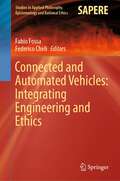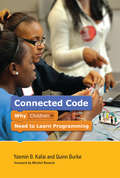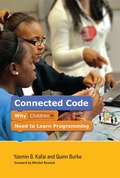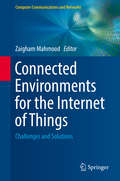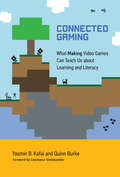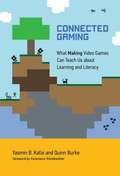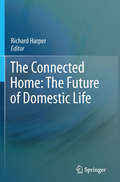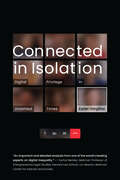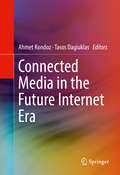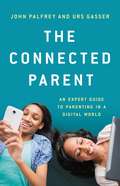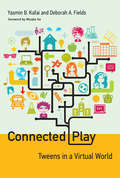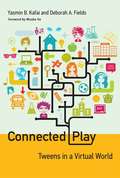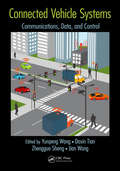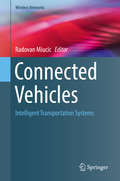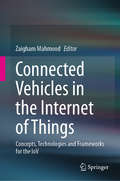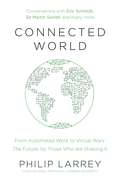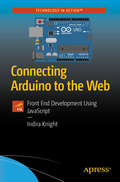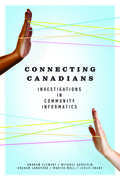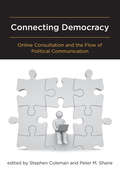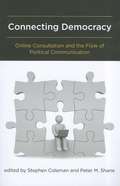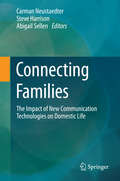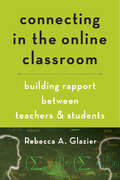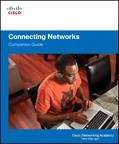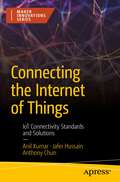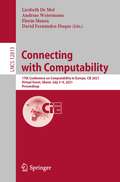- Table View
- List View
Connected and Automated Vehicles: Integrating Engineering and Ethics (Studies in Applied Philosophy, Epistemology and Rational Ethics #67)
by Fabio Fossa Federico CheliThis book reports on theoretical and practical analyses of the ethical challenges connected to driving automation. It also aims at discussing issues that have arisen from the European Commission 2020 report “Ethics of Connected and Automated Vehicles. Recommendations on Road Safety, Privacy, Fairness, Explainability and Responsibility”. Gathering contributions by philosophers, social scientists, mechanical engineers, and UI designers, the book discusses key ethical concerns relating to responsibility and personal autonomy, privacy, safety, and cybersecurity, as well as explainability and human-machine interaction. On the one hand, it examines these issues from a theoretical, normative point of view. On the other hand, it proposes practical strategies to face the most urgent ethical problems, showing how the integration of ethics and technology can be achieved through design practices. All in all, this book fosters a multidisciplinary approach where philosophy, ethics, and engineering are integrated, rather than just juxtaposed. It is meant to inform and inspire an audience of philosophers of technology, ethicists, engineers, developers, manufacturers, and regulators, among other interested readers.
Connected Code: Why Children Need to Learn Programming (The John D. and Catherine T. MacArthur Foundation Series on Digital Media and Learning)
by Yasmin B. Kafai Quinn BurkeWhy every child needs to learn to code: the shift from “computational thinking” to computational participation.Coding, once considered an arcane craft practiced by solitary techies, is now recognized by educators and theorists as a crucial skill, even a new literacy, for all children. Programming is often promoted in K-12 schools as a way to encourage “computational thinking”—which has now become the umbrella term for understanding what computer science has to contribute to reasoning and communicating in an ever-increasingly digital world.In Connected Code, Yasmin Kafai and Quinn Burke argue that although computational thinking represents an excellent starting point, the broader conception of “computational participation” better captures the twenty-first-century reality. Computational participation moves beyond the individual to focus on wider social networks and a DIY culture of digital “making.”Kafai and Burke describe contemporary examples of computational participation: students who code not for the sake of coding but to create games, stories, and animations to share; the emergence of youth programming communities; the practices and ethical challenges of remixing (rather than starting from scratch); and the move beyond stationary screens to programmable toys, tools, and textiles.
Connected Code
by Mitchel Resnick Quinn Burke Yasmin B. KafaiCoding, once considered an arcane craft practiced by solitary techies, is now recognized by educators and theorists as a crucial skill, even a new literacy, for all children. Programming is often promoted in K-12 schools as a way to encourage "computational thinking" -- which has now become the umbrella term for understanding what computer science has to contribute to reasoning and communicating in an ever-increasingly digital world.In Connected Code, Yasmin Kafai and Quinn Burke argue that although computational thinking represents an excellent starting point, the broader conception of "computational participation" better captures the twenty-first-century reality. Computational participation moves beyond the individual to focus on wider social networks and a DIY culture of digital "making." Kafai and Burke describe contemporary examples of computational participation: students who code not for the sake of coding but to create games, stories, and animations to share; the emergence of youth programming communities; the practices and ethical challenges of remixing (rather than starting from scratch); and the move beyond stationary screens to programmable toys, tools, and textiles.
Connected Environments for the Internet of Things: Challenges and Solutions (Computer Communications and Networks)
by Zaigham MahmoodThis comprehensive text/reference presents a broad-ranging overview of device connectivity in distributed computing environments, supporting the vision of an Internet of Things (IoT). Expert perspectives are provided by an international selection of researchers from both industry and academia, covering issues of communication, security, privacy, interoperability, networking, access control, and authentication. In addition to discussing state-of-the-art research and practice, the book includes corporate analyses offering a balanced view of benefits and limitations, and numerous case studies illustrating the challenges and practical solutions. Topics and features: discusses issues of security and privacy in connected environments, with a specific focus on the impact of the IoT paradigm on enterprise information systems; examines the challenges of managing big data in IoT environments, and proposes cloud computing-based solutions to the limitations inherent in the IoT paradigm; suggests approaches to overcome service-level interoperability problems in the IoT environment; introduces a mobile IoT simulator designed to evaluate the behavior of IoT systems, in addition to a novel approach to manage hyper-connectivity in the IoT; describes the use of the Essence framework to model software development methods, and highlights the benefits of integrating data from smart buildings and IoT devices; presents an asymmetric schema matching mechanism for IoT interoperability, and explores the topic of automatic provenance capture at the middleware level; reviews emerging network topologies and communication technologies, and advises on the adoption of a data distribution service as a middleware platform for IoT systems. This practically-oriented volume serves as a complete reference for students, researchers and practitioners of distributed computing, providing insights into the latest approaches, technologies, and frameworks relevant to the IoT environment.
Connected Gaming: What Making Video Games Can Teach Us about Learning and Literacy (The John D. and Catherine T. MacArthur Foundation Series on Digital Media and Learning)
by Yasmin B. Kafai Quinn BurkeHow making and sharing video games offer educational benefits for coding, collaboration, and creativity.Over the last decade, video games designed to teach academic content have multiplied. Students can learn about Newtonian physics from a game or prep for entry into the army. An emphasis on the instructionist approach to gaming, however, has overshadowed the constructionist approach, in which students learn by designing their own games themselves. In this book, Yasmin Kafai and Quinn Burke discuss the educational benefits of constructionist gaming—coding, collaboration, and creativity—and the move from “computational thinking” toward “computational participation.” Kafai and Burke point to recent developments that support a shift to game making from game playing, including the game industry's acceptance, and even promotion, of “modding” and the growth of a DIY culture. Kafai and Burke show that student-designed games teach not only such technical skills as programming but also academic subjects. Making games also teaches collaboration, as students frequently work in teams to produce content and then share their games with in class or with others online. Yet Kafai and Burke don't advocate abandoning instructionist for constructionist approaches. Rather, they argue for a more comprehensive, inclusive idea of connected gaming in which both making and gaming play a part.
Connected Gaming: What Making Video Games Can Teach Us about Learning and Literacy
by Constance Steinkuehler Quinn Burke Yasmin B. KafaiOver the last decade, video games designed to teach academic content have multiplied. Students can learn about Newtonian physics from a game or prep for entry into the army. An emphasis on the instructionist approach to gaming, however, has overshadowed the constructionist approach, in which students learn by designing their own games themselves. In this book, Yasmin Kafai and Quinn Burke discuss the educational benefits of constructionist gaming -- coding, collaboration, and creativity -- and the move from "computational thinking" toward "computational participation." Kafai and Burke point to recent developments that support a shift to game making from game playing, including the game industry's acceptance, and even promotion, of "modding" and the growth of a DIY culture. Kafai and Burke show that student-designed games teach not only such technical skills as programming but also academic subjects. Making games also teaches collaboration, as students frequently work in teams to produce content and then share their games with in class or with others online. Yet Kafai and Burke don't advocate abandoning instructionist for constructionist approaches. Rather, they argue for a more comprehensive, inclusive idea of connected gaming in which both making and gaming play a part.
The Connected Home: The Future of Domestic Life
by Richard HarperThe title of this new book: "The Connected Home" reflects the move away from the idea that smart homes would alter the lives of those living in them by providing technologies to take over tasks that were previously the responsibility of the householder, such as managing entertainment, education - and even eating! Up until around 10 years ago this view was commonplace but time has shown that the technologies to support a smart home have not developed in such a way as to support this premise. Instead, what people do in their homes has moved the concept of a smart home into that of the 'connected home'. The rise of on-line games technologies, video connections via Skype, social networking, internet browsing etc are now an integral part of the home environment and have had a significant effect on the home. The contributors to this exciting new book consider and discuss the effects and ramifications of the connected home from a variety of viewpoints: an examination of the take-up of personal computers and the Internet in domestic situations; an analysis of the changing intersection of technology and human habits in the connected home; the impact of gaming, texting, e-book readers, tablets and other devices and their effect on the social conditions of a household; the relationship between digital messaging applications and real geography; and an overview of how sensing technologies for the smart home might evolve (lightweight medical technologies for example). The book culminates by addressing unfinished ambitions from the smart home agenda, the factors that have prevented their realisation, and addresses the need for extending research into the area.
Connected in Isolation: Digital Privilege in Unsettled Times
by Eszter HargittaiWhat life during lockdown reveals about digital inequality.The vast majority of people in wealthy, highly connected, or digitally privileged societies may have crossed the digital divide, but being online does not mean that everyone is equally connected—and digital inequality reflects experience both online and off. In Connected in Isolation Eszter Hargittai looks at how this digital disparity played out during the unprecedented isolation imposed in the early days of the coronavirus pandemic. During initial COVID-19 lockdowns the Internet, for many, became a lifeline, as everything from family get-togethers to doctor&’s visits moved online. Using survey data collected in April and May of 2020 in the United States, Italy, and Switzerland, Hargittai explores how people from varied backgrounds and differing skill levels were able to take advantage of digital media to find the crucial information they needed—to help loved ones, procure necessities, understand rules and risks. Her study reveals the extent to which long-standing social and digital inequalities played a critical role in this move toward computer-mediated communication—and were often exacerbated in the process. However, Hargittai notes, context matters: her findings reveal that some populations traditionally disadvantaged with technology, such as older people, actually did better than others, in part because of the continuing importance of traditional media, television in particular. The pandemic has permanently shifted how reliant we are upon online information, and the implications of Hargittai&’s groundbreaking comparative research go far beyond the pandemic. Connected in Isolation informs and expands our understanding of digital media, including how they might mitigate or worsen existing social disparities; whom they empower or disenfranchise; and how we can identify and expand the skills people bring to them.
Connected Media in the Future Internet Era
by Ahmet Kondoz Tasos DagiuklasThis book describes recent innovations in 3D media and technologies, with coverage of 3D media capturing, processing, encoding, and adaptation, networking aspects for 3D Media, and quality of user experience (QoE). The contributions are based on the results of the FP7 European Project ROMEO, which focuses on new methods for the compression and delivery of 3D multi-view video and spatial audio, as well as the optimization of networking and compression jointly across the future Internet. The delivery of 3D media to individual users remains a highly challenging problem due to the large amount of data involved, diverse network characteristics and user terminal requirements, as well as the user's context such as their preferences and location. As the number of visual views increases, current systems will struggle to meet the demanding requirements in terms of delivery of consistent video quality to fixed and mobile users. ROMEO will present hybrid networking solutions that combine the DVB-T2 and DVB-NGH broadcast access network technologies together with a QoE aware Peer-to-Peer (P2P) distribution system that operates over wired and wireless links. Live streaming 3D media needs to be received by collaborating users at the same time or with imperceptible delay to enable them to watch together while exchanging comments as if they were all in the same location. This book is the last of a series of three annual volumes devoted to the latest results of the FP7 European Project ROMEO. The present volume provides state-of-the-art information on 3D multi-view video, spatial audio networking protocols for 3D media, P2P 3D media streaming, and 3D Media delivery across heterogeneous wireless networks among other topics. Graduate students and professionals in electrical engineering and computer science with an interest in 3D Future Internet Media will find this volume to be essential reading.
The Connected Parent: An Expert Guide to Parenting in a Digital World
by John Palfrey Urs GasserAn essential guide for parents navigating the new frontier of hyper-connected kids.Today's teenagers spend about nine hours per day online. Parents of this ultra-connected generation struggle with decisions completely new to parenting: Should an eight-year-old be allowed to go on social media? How can parents help their children gain the most from the best aspects of the digital age? How can we keep kids safe from digital harm? John Palfrey and Urs Gasser bring together over a decade of research at Harvard to tackle parents' most urgent concerns. The Connected Parent is required reading for anyone trying to help their kids flourish in the fast-changing, uncharted territory of the digital age.
Connected Play: Tweens in a Virtual World (The John D. and Catherine T. MacArthur Foundation Series on Digital Media and Learning)
by Yasmin B. Kafai Deborah A. FieldsHow kids play in virtual worlds, how it matters for their offline lives, and what this means for designing educational opportunities.Millions of children visit virtual worlds every day. In such virtual play spaces as Habbo Hotel, Toontown, and Whyville, kids chat with friends from school, meet new people, construct avatars, and earn and spend virtual currency. In Connected Play, Yasmin Kafai and Deborah Fields investigate what happens when kids play in virtual worlds, how this matters for their offline lives, and what this means for the design of educational opportunities in digital worlds. Play is fundamentally important for kids' development, but, Kafai and Fields argue, to understand play in virtual worlds, we need to connect concerns of development and culture with those of digital media and learning. Kafai and Fields do this through a detailed study of kids' play in Whyville, a massive, informal virtual world with educational content for tween players. Combining ethnographic accounts with analysis of logfile data, they present rich portraits and overviews of how kids learn to play in a digital domain, developing certain technological competencies; how kids learn to play well—responsibly, respectfully, and safely; and how kids learn to play creatively, creating content that becomes a part of the virtual world itself.
Connected Play: Tweens in a Virtual World
by Yasmin B. Kafai Deborah A. FieldsMillions of children visit virtual worlds every day. In such virtual play spaces as Habbo Hotel, Toontown, and Whyville, kids chat with friends from school, meet new people, construct avatars, and earn and spend virtual currency. In "Connected Play," Yasmin Kafai and Deborah Fields investigate what happens when kids play in virtual worlds, how this matters for their offline lives, and what this means for the design of educational opportunities in digital worlds. Play is fundamentally important for kids development, but, Kafai and Fields argue, to understand play in virtual worlds, we need to connect concerns of development and culture with those of digital media and learning. Kafai and Fields do this through a detailed study of kids play in Whyville, a massive, informal virtual world with educational content for tween players. Combining ethnographic accounts with analysis of logfile data, they present rich portraits and overviews of how kids learn to play in a digital domain, developing certain technological competencies; how kids learn to play well -- responsibly, respectfully, and safely; and how kids learn to play creatively, creating content that becomes a part of the virtual world itself.
Connected Vehicle Systems: Communication, Data, and Control
by Yunpeng Wang Daxin Tian Zhengguo Sheng Wang JianConnected vehicles and intelligent vehicles have been identified as key technologies for increasing road safety and transport efficiency. This book presents and discusss the recent advances in theory and practice in connected vehicle systems. It covers emerging research that aims at dealing with the challenges in designing the essential functional components of connected vehicles. Major topics include intra- and inter-vehicle communications, mobility model of fleet and ramp merging, trace and position data analysis, security and privacy.
Connected Vehicles: Intelligent Transportation Systems (Wireless Networks)
by Radovan MiucicThis book introduces concepts and technologies of Intelligent Transportation Systems (ITS). It describes state of the art safety communication protocol called Dedicated Short Range Communication (DSRC), currently being considered for adoption by the USDOT and automotive industry in the US. However, the principles of this book are applicable even if the underlying physical layer protocol of V2X changes in the future, e.g. V2X changes from DSRC to cellular-based connectivity. Fundamental ITS concepts include topics like global positioning system; Vehicle to Vehicle (V2V), Vehicle to Pedestrian (V2P), and Vehicle to Infrastructure (V2I) communications; human-machine interface; and security and privacy. Fundamental concepts are sometimes followed by the real-life test experimental results (such as in V2P Chapter) and description of the performance metrics used to evaluate the results. This book also describes equations and math used in the development of the individual parts of the system. This book surveys current and previous publications for trending research in the ITS domain. It also covers state of the art standards that are in place for the DSRC in the US, starting from the application layer defined in SAE J2735 all the way to physical layer defined in IEEE 802.11. The authors provide a detailed discussion on what is needed to extend the current standards to accommodate future needs of the vehicle communications, such as needs for future autonomous vehicles. Programs and code examples accompany appropriate chapters, for example, after describing remote vehicle target classification function a pseudo code and description is provided. In addition, the book discusses current topics of the technology such as spectrum sharing, simulation, security, and privacy. The intended audience for this book includes engineering graduate students, automotive professionals/engineers, researchers and technology enthusiasts.
Connected Vehicles in the Internet of Things: Concepts, Technologies and Frameworks for the IoV
by Zaigham MahmoodThis book presents an overview of the latest smart transportation systems, IoV connectivity frameworks, issues of security and safety in VANETs, future developments in the IoV, technical solutions to address key challenges, and other related topics. A connected vehicle is a vehicle equipped with Internet access and wireless LAN, which allows the sharing of data through various devices, inside as well as outside the vehicle. The ad-hoc network of such vehicles, often referred to as VANET or the Internet of vehicles (IoV), is an application of IoT technology, and may be regarded as an integration of three types of networks: inter-vehicle, intra-vehicle, and vehicular mobile networks. VANET involves several varieties of vehicle connectivity mechanisms, including vehicle-to-infrastructure (V2I), vehicle-to-vehicle (V2V), vehicle-to-cloud (V2C), and vehicle-to-everything (V2X). According to one survey, it is expected that there will be approximately 380 million connected cars on the roads by 2020. IoV is an important aspect of the new vision for smart transportation. The book is divided into three parts: examining the evolution of IoV (basic concepts, principles, technologies, and architectures), connectivity of vehicles in the IoT (protocols, frameworks, and methodologies), connected vehicle environments and advanced topics in VANETs (security and safety issues, autonomous operations, machine learning, sensor technology, and AI). By providing scientific contributions and workable suggestions from researchers and practitioners in the areas of IoT, IoV, and security, this valuable reference aims to extend the body of existing knowledge.
Connected World: From Automated Work to Virtual Wars: The Future, By Those Who Are Shaping It
by Father Philip LarreyThe world as we know it is changing. Driverless cars, drone deliveries and autonomous weapon systems are no longer the stuff of science fiction.But what's next for technology and business, and how will it impact our society?In Connected World, Philip Larrey of the Pontifical Lateran University explores the consequences of the new digital age in conversation with leaders including Sir Martin Sorrell, CEO of WPP, Eric Schmidt, CEO of Google's parent company Alphabet, and Maurice Lévy, CEO of Publicis Groupe.Ranging from the death of privacy to the rise of artificial intelligence, Connected World asks the existential questions which will come to define our age.
Connecting Arduino to the Web: Front End Development Using JavaScript
by Indira KnightCreate physical interfaces that interact with the Internet and web pages. With Arduino and JavaScript you can create interactive physical displays and connected devices that send data to or receive data from the web. You'll take advantage of the processes needed to set up electronic components, collect data, and create web pages able to interact with electronic components.Through exercises, projects, and explanations, this book will give you the core front end web development and electronics skills needed to create connected physical interfaces and build compelling visualizations with a range of JavaScript libraries.By the end of the book you will have developed fully working interactive prototypes capable of sending data to and receiving data from a physical interface. Most importantly, Connecting Arduino to the Web will give you a taste of what is possible and the knowledge to create your own connected physical interfaces and bring the web into your electronics projects.What You'll LearnBuild an Internet of Things dashboard that updates with electronics attached to an ArduinoUse components to interact with online 3D displaysCreate web pages with HTML and CSSSet up a Node.js serverUse WebSockets to process live dataInteract with scalable vector graphics (SVG)Who This Book Is ForTechnologists, developers, and enthusiasts looking to extend their skills, be able to develop physical prototypes with connected devices, and with an interest in getting started with IoT. Also, those excited by the possibilities of connecting the physical and the web.
Connecting Canadians: Investigations in Community Informatics
by Andrew Clement Michael Gurstein Graham Longford Marita Moll Leslie Regan ShadeConnecting Canadians represents the work of the Community Research Alliance for Community Innovation and Networking (CRACIN), the largest national and international research effort to examine the burgeoning field of community informatics, a cross-disciplinary approach to the mobilization of information and communications technologies (ICT) for community change. Funded for four years by the SSHRC's Initiative for the New Economy, CRACIN systematically studied a wide variety of Canadian community ICT initiatives, bringing perspectives from sociology, computer science, critical theory, women's studies, library and information sciences, and management studies to bear on networking technologies. A comprehensive thematic account of this in-depth research, Connecting Canadians will be an essential resource for NGOs, governments, the private sector, and multilateral agencies across the globe.
Connecting Democracy: Online Consultation and the Flow of Political Communication (The\mit Press Ser.)
by Stephen Coleman Peter M. ShaneAn investigation of the effect of government online forums on democratic practices in the United States and Europe.The global explosion of online activity is steadily transforming the relationship between government and the public. The first wave of change, “e-government,” enlisted the Internet to improve management and the delivery of services. More recently, “e-democracy” has aimed to enhance democracy itself using digital information and communication technology. One notable example of e-democratic practice is the government-sponsored (or government-authorized) online forum for public input on policymaking. This book investigates these “online consultations” and their effect on democratic practice in the United States and Europe, examining the potential of Internet-enabled policy forums to enrich democratic citizenship.The book first situates the online consultation phenomenon in a conceptual framework that takes into account the contemporary media environment and the flow of political communication; then offers a multifaceted look at the experience of online consultation participants in the United States, the United Kingdom, and France; and finally explores the legal architecture of U.S. and E. U. online consultation. As the contributors make clear, online consultations are not simply dialogues between citizens and government but constitute networked communications involving citizens, government, technicians, civil society organizations, and the media. The topics examined are especially relevant today, in light of the Obama administration's innovations in online citizen involvement.
Connecting Democracy
by Stephen Coleman Peter M. ShaneThe global explosion of online activity is steadily transforming the relationship between government and the public. The first wave of change, "e-government," enlisted the Internet to improve management and the delivery of services. More recently, "e-democracy" has aimed to enhance democracy itself using digital information and communication technology. One notable example of e-democratic practice is the government-sponsored (or government-authorized) online forum for public input on policymaking. This book investigates these "online consultations" and their effect on democratic practice in the United States and Europe, examining the potential of Internet-enabled policy forums to enrich democratic citizenship. The book first situates the online consultation phenomenon in a conceptual framework that takes into account the contemporary media environment and the flow of political communication; then offers a multifaceted look at the experience of online consultation participants in the United States, the United Kingdom, and France; and finally explores the legal architecture of U. S. and E. U. online consultation. As the contributors make clear, online consultations are not simply dialogues between citizens and government but constitute networked communications involving citizens, government, technicians, civil society organizations, and the media. The topics examined are especially relevant today, in light of the Obama administration's innovations in online citizen involvement.
Connecting Families: The Impact of New Communication Technologies on Domestic Life (Computer Supported Cooperative Work Ser.)
by Carman Neustaedter Steve Harrison Abigail SellenNew technologies are radically changing the way that families connect with one another: we can text our teenagers from work, eat dinner with far-away parents via video link, and instantly upload and share photos after a family day out. Whether we are bridging time or distance, and whether we are enhancing our closest relationships or strengthening the bonds of extended family, as computer technologies alter the communication landscape, they in turn are changing the way we conduct and experience family life. This state of the art volume explores the impact of new communication systems on how families interact - how they share their lives and routines, engage in social touch, and negotiate being together or being apart - by considering a range of different family relationships that shape the nature of communication. Composed of three sections, the first looks at what is often the core of a 'family', the couple, to understand the impact of technology on couple relationships, communication, and feelings of closeness. The second section studies immediate families that have expanded beyond just the individual or couple to include children. Here, the emphasis is on connection for communication, coordination, and play. The third section moves beyond the immediate family to explore connections between extended, distributed family members. This includes connections between adult children and their parents, grandparents and grandchildren, and adult siblings. Here family members have grown older, moved away from 'home', and forged new families. Researchers, designers and developers of new communication technologies will find this volume invaluable. Connecting Families: The Impact of New Communication Technologies on Domestic Life brings together the most up-to-date studies to help in understanding how new communication technologies shape - and are shaped by - family life, and offers inspiration and guidance for design by making clear what families need and value from technological systems.
Connecting in the Online Classroom: Building Rapport between Teachers and Students
by Rebecca A. GlazierBuilding rapport with students can revive the promise of online education, leading to greater success for students, more fulfilling teaching experiences for faculty, and improved enrollment for universities.More students than ever before are taking online classes, yet higher education is facing an online retention crisis; students are failing and dropping out of online classes at dramatically higher rates than face-to-face classes. Grounded in academic research, original surveys, and experimental studies, Connecting in the Online Classroom demonstrates how connecting with students in online classes through even simple rapport-building efforts can significantly improve retention rates and help students succeed. Drawing on more than a dozen years of experience teaching and researching online, Rebecca Glazier provides practical, easy-to-use techniques that online instructors can implement right away to begin building rapport with their students, including • proactively reaching out through personalized check-in emails;• creating opportunities for human connection before courses even begin through a short welcome survey;• communicating faculty investment in students' success by providing individualized and meaningful assignment feedback;• hosting non-content-based discussion threads where students and faculty can get to know one other; and• responding to students' questions with positivity and encouragement (and occasionally also cute animal pictures).She also presents case studies of universities that are already using these strategies, along with specific, data-driven recommendations for administrators, making the book valuable for faculty, instructional designers, support staff, and administrators alike. The science-backed strategies that Glazier provides will enable instructors to connect with their students and help those students thrive. Speaking to the paradox of online learning, the book also explains that, although the great promise of online education is expanded access and greater equity—especially for traditionally underserved and hard-to-reach populations, like lower-income students, working parents, first-generation students, and students of color—the current gap between online and face-to-face retention means universities are falling far short of this promise.
Connecting Networks Companion Guide
by Cisco Networking AcademyThis course discusses the WAN technologies and network services required by converged applications in a complex network. The course allows you to understand the selection criteria of network devices and WAN technologies to meet network requirements. You will learn how to configure and troubleshoot network devices and resolve common issues with data link protocols. You will also develop the knowledge and skills needed to implement IPSec and virtual private network (VPN) operations in a complex network.
Connecting the Internet of Things: IoT Connectivity Standards and Solutions
by Anil Kumar Jafer Hussain Anthony ChunNavigating the fragmented IoT connectivity ecosystem of standards, protocols, and architectures can be a challenge. Not to mention scaling a solution to a viable product. This book guides you through this fractured landscape with real world examples and projects that can be leverage for an IoT product. Backed by an overview of IoT use cases and key connectivity elements of IoT solutions, you'll gain an understanding of the breadth of the IoT landscape and the fragmentation of connectivity standards and solutions and the challenge in navigating the many standards and technologies. You'll also be able to understand the essentials of connectivity including, hardware, software, and business models. IoT is essential for increasing productivity of many industries and quality of life (making the world smart and autonomous). Both wired and wireless connectivity technologies are essential ingredients in an IoT product. Written by Intel engineers and architects, Connecting the Internet of Things understands that connectivity is a key topic of IoT and comprehensively covers the topic from a system engineering and practical perspective.What You'll LearnUnderstand the trade offs between different wireless technologies and network topologiesUse wireless technologies in IoT productsExamine connectivity technologies and considerations on selecting it for the IoT use casesAssemble all of the components of a working solution Scale your solution to a productReview emerging connectivity technologies for addressing new use casesAdvance and optimize the performance of existing technologiesWho This Book Is ForResearchers, managers, strategists, technologists, makers, and students in the embedded and Internet of Things (IoT) space trying to understand and implement connectivity in the devices/platforms.
Connecting with Computability: 17th Conference on Computability in Europe, CiE 2021, Virtual Event, Ghent, July 5–9, 2021, Proceedings (Lecture Notes in Computer Science #12813)
by Florin Manea Liesbeth De Mol Andreas Weiermann David Fernández-DuqueThis book constitutes the proceedings of the 17th Conference on Computability in Europe, CiE 2021, organized by the University of Ghent in July 2021. Due to COVID-19 pandemic the conference was held virtually.The 48 full papers presented in this volume were carefully reviewed and selected from 50 submissions. CiE promotes the development of computability-related science, ranging over mathematics, computer science and applications in various natural and engineering sciences, such as physics and biology, as well as related fields, such as philosophy and history of computing. CiE 2021 had as its motto Connecting with Computability, a clear acknowledgement of the connecting and interdisciplinary nature of the conference series which is all the more important in a time where people are more than ever disconnected from one another due to the COVID-19 pandemic.
